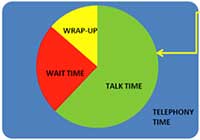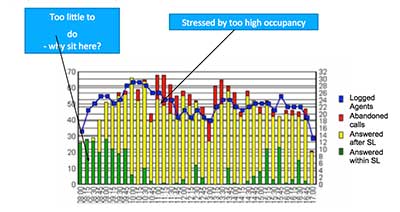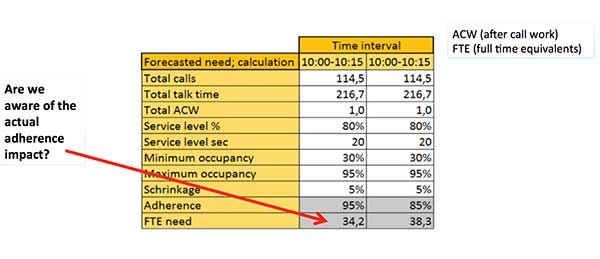Adherence – from a strategic & employee perspective
Adherence – from a strategic & employee perspective

I recently gave a webinar entitled: “Adherence from a strategic and employee perspective.” Adherence is one of the most important KPIs (Key Performance Indicators) of the customer-service industry. My aim then was, and is now, for contact-centre managers to understand that decisions about adherence have an impact on forecasted need and attrition, team-leader administration and agent stress levels.
Not making strategic decisions about adherence – or not making the right ones – often leads to sub-optimization and agent discomfort. The areas addressed/recommended here are the following:
- What to think about when deciding on objectives for adherence
- Avoiding unnecessary administration and sub–optimization related to adherence
- When coaching employees, use adherence to increase the service level
- Making adherence a joint concern among resource planners, team leaders and agents
In calculating the service level you want to achieve, two important metrics must enter into the equation: shrinkage and occupancy. Shrinkage is scheduled time not interacting with customers. For occupancy, see the circle diagram further down for clarification.
In the table below, everything being equal, lowering adherence from 95 to 85 percent necessitates an additional 4 FTEs for that 15-minute time interval. If the adherence target is not met, you’ll be understaffed, which translates to too high an occupancy rate, which leads to stressed-out agents, which, in turn, potentially results in agent burnout, higher absenteeism and attrition further on down the road.
Beyond calculating for efficiency and costs, calculating realistic target levels for occupancy and adherence should also be done. In fact, they should be strategic decisions. Why? Because they impact the overall stress levels of your agents, which ultimately affects your entire business – for good or for bad.
Occupancy and adherence
 Take the blue square to the right to represent scheduled telephony time. To calculate the percentage of occupancy, divide the green and yellow parts of the circle by the complete circle. For adherence, divide the complete circle by the blue square.
Take the blue square to the right to represent scheduled telephony time. To calculate the percentage of occupancy, divide the green and yellow parts of the circle by the complete circle. For adherence, divide the complete circle by the blue square.
There is no hard-and-fast rule regarding the right occupancy level: it depends on your situation. For example, if you were to have a sales campaign that gave agents the incentive to earn commissions on sales, they’d be highly motivated to respond to as many interactions as possible. In this scenario, they’d want high occupancy (i.e. low wait time). Agents could, in fact, feel stressed out with too low an occupancy rate, waiting for calls!
The reverse scenario is a contact centre where nurses deal with medical emergencies. Although a high level of ready time/adherence is generally a good working model, too high an occupancy rate could be a strain for these nurses, leading to understaffing and hence, negative stress. You’d need to plan for an occupancy level that gives enough wait time so nurses can take breaks and catch their breath.
If you’re using an automated workforce-management programme, you may notice low adherence for some or many agents in relation to the scheduled adherence target. Don’t just jump the gun and immediately blame those agents in question or worse, fiddle with the schedule – adding activities after the fact to make adherence look better. I’ve seen many team leaders do this. Not only is this costly but it also prevents accurate analysis of identifying the weak spots. Instead, be glad that low adherence is signalling a problem in order for you to be able to come up with constructive measures.
Tackling where it matters
Perhaps a closer look should be taken at your policies and processes. Targets may not be realistic. Furthermore, are resource planners that schedule vacations, activities, etc., leaving enough idle time? Do team leaders, in coaching agents, keep them motivated and aligned with adherence targets? Do they actually help and enable them to adhere? These two entities – planning and operations – must cooperate as a team, working together toward achieving the same goals.
Furthermore, do not use adherence for its own sake. Instead, utilise accurate forecasting and intraday management tools. They are not to be underestimated. Intraday management takes into account the short-term perspective: a schedule is, after all, flexible but changes need to be made before the fact, not after.
Final word of advice – involve your agents!
 In all my years of working with contact centres, I cannot understate the importance of including agents in problem solving. We don’t often involve them, yet they’re the ones who often have the best answers. Become more transparent. Share adherence data as self-assessment for agents and in coaching. Make adherence your carrot, not your whip! At Calabrio, we call it scheduling and monitoring – with a human touch. This leads to a spirit of cooperation where agents help improve efficiency.
In all my years of working with contact centres, I cannot understate the importance of including agents in problem solving. We don’t often involve them, yet they’re the ones who often have the best answers. Become more transparent. Share adherence data as self-assessment for agents and in coaching. Make adherence your carrot, not your whip! At Calabrio, we call it scheduling and monitoring – with a human touch. This leads to a spirit of cooperation where agents help improve efficiency.
Share, for example, an actual service-level chart, such as the one depicted to the right, to help them understand the impact of adherence. By letting them be part of the solution, you’ll be amazed how empowered and motivated they’ll feel. I’ve seen it happen again and again! They’ll take actions and find solutions – “We can fix that,” or “We’ll cover the lunch break better,” etc., resulting in a win-win outcome.










